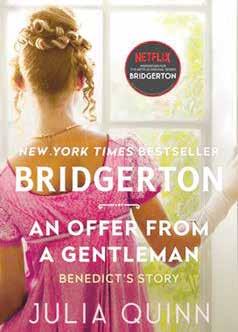
3 minute read
The Last Word
BRIDGERTON
Welcome to the world of sex, scandel, high society, and petty drama.
“It is a truth universally acknowledged, that a single man in possession of a good fortune, must be in want of a wife.” In her eight Regency historical romances, focusing on the family Bridgerton from 1813-1827, Julia Quinn might take this introductory sentence to Jane Austen’s Pride and Prejudice and slightly re-write it: “It is a truth acknowledged in the Bridgerton family, that any Bridgerton heir has enough money to marry well and for love, and should do so post-haste.” If you have binged the two costume-drama seasons on Netflix, with Shonda Rhimes as the showrunner, you will mostly know what to expect.
The highly popular novels do take a slightly more serious tone at times. Their titles are as follows: The Duke and I (Daphne), The Viscount Who Loved Me (Anthony), An Offer From a Gentleman (Benedict), Romancing Mr. Bridgerton (Colin), To Sir Phillip, With Love (Eloise), When He Was Wicked (Francesca), It’s in His Kiss (Hyacinth), and On the Way to the Wedding (Gregory).
The Bridgerton family, heir to the deceased Viscount Edmund and vibrant Viscountess Violet, comprises eight stair-step children named in alphabetical order according to age. Anthony, the Viscount-to-be, is pressured by the responsibility that will fall on his shoulders of looking out for his siblings. Next come Benedict, Colin, Daphne, Eloise, Francesca, Gregory, and Hyacinth. With a loving, wise mother ready to push her children into society to find spouses, Quinn puts a happier, lighter spin on the Austen society satire and adds in the boisterous nature of an exceptionally large family whose members all adore and support one another.
The first novels start with comments from a lighthearted, acerbic, and anonymous society maven named Lady Whistledown, who knows everything about the glittering society in which the Bridgertons move. In a newsletter published twice a week, she dashes off pointed observations about them and others in their milieu, called the ton. In the fourth book we find out her identity as she ends her broadsheet, but her asides make the first books enjoyable.
As they reach their majority, the Viscount’s offspring each get a novel about their search for love and fulfillment, with either the Bridgerton or potential spouse brooding over an implausible worry that prevents true love from running smooth. Their focus on their love interests grows slowly, until they cannot imagine not having these people in their lives. Often this interest is accompanied by a type of personal growth, encouraged by their wise mother, Violet, and the situations they find themselves in.
In the classic manner of female wish-fulfillment romance tales, some of the young women are not conventionally beautiful, but worthy with personalities that complement their male suitors. The men, on the other hand, are all dashing, very handsome, and sometimes rakes with unsavory pasts full of dalliances with unsuitable opera singers and married women. If they are left along with unmarried gentlewomen, on the other hand, the pressure is on to marry the compromised ladies. They, of course, no longer want to stray once they meet the women they love.
It is refreshing to see the women loved for their spunk, forthrightness, and character along with their looks, instead of for being coy, conventional misses showing decorum and servile natures to win a man. In this Quinn deviates somewhat from romance novel formulas, but certainly follows the path of Jane Austen’s character Elizabeth Bennett
THE LAST WORD > PAGE 13


Based on Julia Quinn’s hugely popular period drama romance novel series, The Bridgertons, Netflix’s eight-part series centres around Lady Whistledown and unpicks all of the wrongdoings, affairs and shameful behaviour of the high society individuals, notably the Bridgertons.

